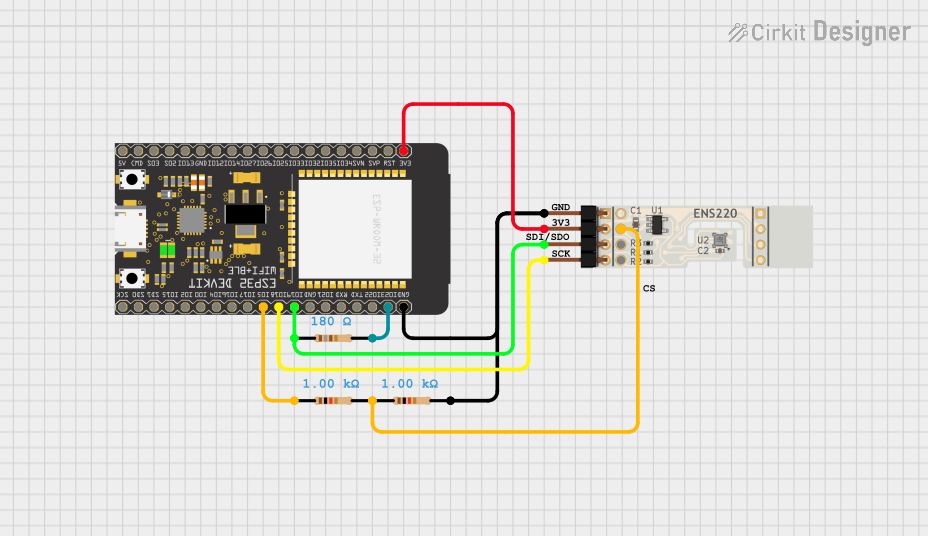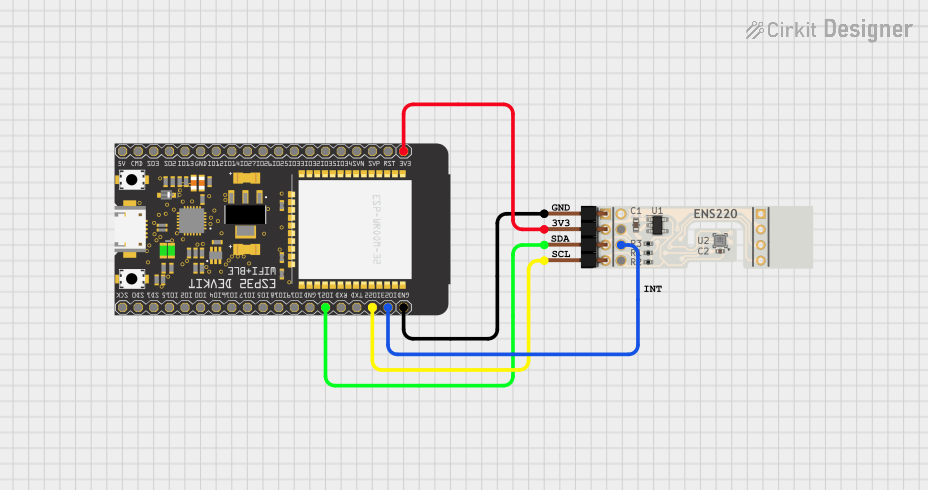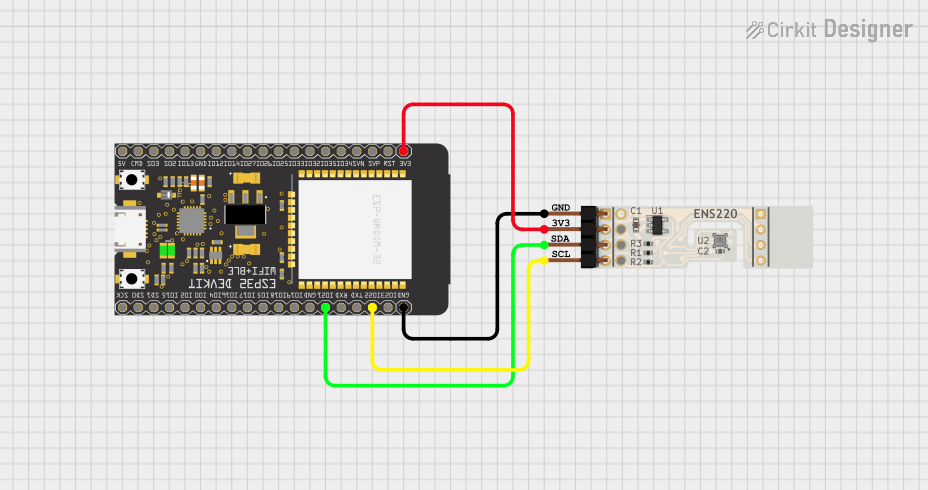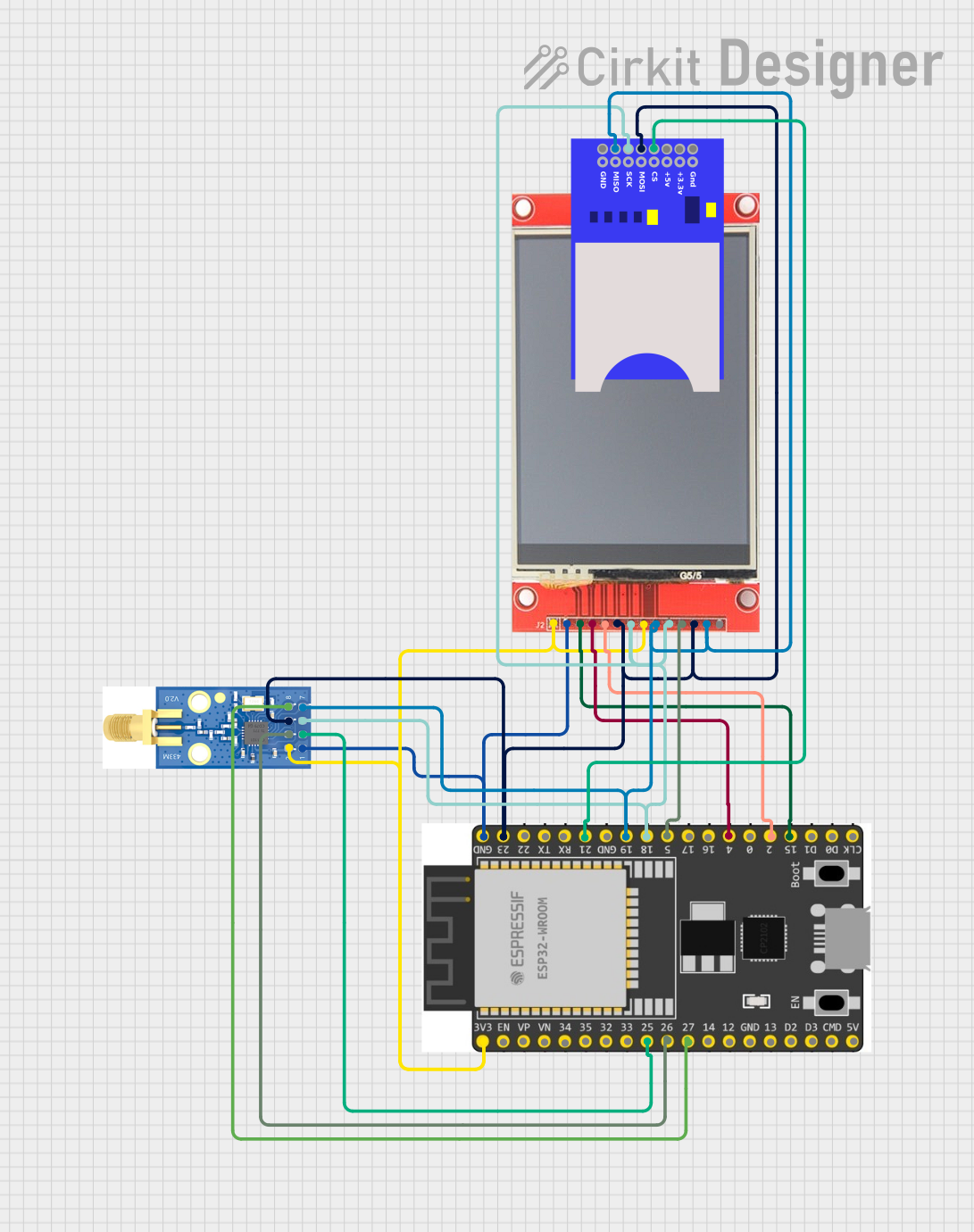
How to Use ENS161_Evaluation_Kit_SPI: Examples, Pinouts, and Specs

 Design with ENS161_Evaluation_Kit_SPI in Cirkit Designer
Design with ENS161_Evaluation_Kit_SPI in Cirkit DesignerIntroduction
The ENS161 Evaluation Kit (ENS161_EvalKit_v3.3_SPI), manufactured by ScioSense, is a development tool designed to test and evaluate the capabilities of the ENS161 air quality sensor. The ENS161 sensor is a digital metal-oxide gas sensor capable of detecting various gases, including volatile organic compounds (VOCs) and nitrogen oxides (NOx). This evaluation kit features a Serial Peripheral Interface (SPI) for seamless communication with microcontrollers and other devices, making it ideal for prototyping and integration into air quality monitoring systems.
Explore Projects Built with ENS161_Evaluation_Kit_SPI

 Open Project in Cirkit Designer
Open Project in Cirkit Designer
 Open Project in Cirkit Designer
Open Project in Cirkit Designer
 Open Project in Cirkit Designer
Open Project in Cirkit Designer
 Open Project in Cirkit Designer
Open Project in Cirkit DesignerExplore Projects Built with ENS161_Evaluation_Kit_SPI

 Open Project in Cirkit Designer
Open Project in Cirkit Designer
 Open Project in Cirkit Designer
Open Project in Cirkit Designer
 Open Project in Cirkit Designer
Open Project in Cirkit Designer
 Open Project in Cirkit Designer
Open Project in Cirkit DesignerCommon Applications and Use Cases
- Indoor air quality monitoring
- Smart home and building automation
- HVAC systems
- Air purifiers and ventilation systems
- IoT-based environmental sensing
Technical Specifications
The ENS161 Evaluation Kit is designed to simplify the evaluation of the ENS161 sensor. Below are the key technical details:
Key Technical Details
| Parameter | Value |
|---|---|
| Supply Voltage | 3.3V |
| Communication Interface | SPI |
| Operating Temperature Range | -40°C to +85°C |
| Power Consumption | < 10 mW (typical) |
| Sensor Type | Metal-oxide gas sensor |
| Measured Gases | VOCs, NOx |
| Dimensions | 25 mm x 25 mm x 5 mm |
Pin Configuration and Descriptions
The ENS161 Evaluation Kit features a standard SPI interface with the following pinout:
| Pin Name | Pin Number | Description |
|---|---|---|
| VCC | 1 | Power supply input (3.3V) |
| GND | 2 | Ground |
| SCLK | 3 | SPI clock input |
| MOSI | 4 | SPI Master Out Slave In (data input to ENS161) |
| MISO | 5 | SPI Master In Slave Out (data output from ENS161) |
| CS | 6 | Chip Select (active low) |
| INT | 7 | Interrupt output (optional, for event signaling) |
Usage Instructions
How to Use the ENS161 Evaluation Kit in a Circuit
- Power Supply: Connect the VCC pin to a 3.3V power source and the GND pin to ground.
- SPI Communication: Connect the SCLK, MOSI, MISO, and CS pins to the corresponding SPI pins on your microcontroller.
- Interrupt Pin (Optional): If required, connect the INT pin to a GPIO pin on your microcontroller to handle sensor events.
- Initialization: Configure the SPI interface on your microcontroller with the following settings:
- Clock polarity (CPOL): 0
- Clock phase (CPHA): 0
- Data order: MSB first
- Data Reading: Use SPI commands to read sensor data and interpret the results according to the ENS161 datasheet.
Important Considerations and Best Practices
- Ensure the power supply is stable and within the specified range (3.3V).
- Use proper pull-up or pull-down resistors on the SPI lines if required by your microcontroller.
- Avoid placing the sensor in environments with high humidity or condensation, as this may affect its performance.
- Allow the sensor to warm up for a few minutes after power-up to ensure accurate readings.
Example Code for Arduino UNO
Below is an example of how to interface the ENS161 Evaluation Kit with an Arduino UNO using SPI:
#include <SPI.h>
// Define SPI pins for the ENS161 Evaluation Kit
const int CS_PIN = 10; // Chip Select pin
void setup() {
// Initialize serial communication for debugging
Serial.begin(9600);
// Configure SPI settings
SPI.begin();
pinMode(CS_PIN, OUTPUT);
digitalWrite(CS_PIN, HIGH); // Set CS pin to idle state
Serial.println("ENS161 Evaluation Kit SPI Example");
}
void loop() {
// Example: Read data from the ENS161 sensor
digitalWrite(CS_PIN, LOW); // Select the ENS161 sensor
byte command = 0x01; // Example command to read data
byte response = SPI.transfer(command); // Send command and receive response
digitalWrite(CS_PIN, HIGH); // Deselect the sensor
// Print the received data
Serial.print("Sensor Data: ");
Serial.println(response, HEX);
delay(1000); // Wait 1 second before the next read
}
Notes:
- Replace
0x01with the actual command to read data from the ENS161 sensor, as specified in the ENS161 datasheet. - Ensure the SPI library is properly configured for your Arduino board.
Troubleshooting and FAQs
Common Issues and Solutions
No Data from the Sensor
- Cause: Incorrect SPI configuration or wiring.
- Solution: Verify the SPI settings (CPOL, CPHA, data order) and ensure all connections are secure.
Inconsistent Readings
- Cause: Insufficient warm-up time or unstable power supply.
- Solution: Allow the sensor to warm up for at least 5 minutes and ensure a stable 3.3V power source.
Sensor Not Responding
- Cause: Chip Select (CS) pin not properly controlled.
- Solution: Ensure the CS pin is set to LOW before sending SPI commands and HIGH after communication.
FAQs
Q: Can the ENS161 Evaluation Kit be used with I2C instead of SPI?
A: No, this version of the evaluation kit (ENS161_EvalKit_v3.3_SPI) is specifically designed for SPI communication. For I2C, a different version of the kit may be required.
Q: How do I interpret the sensor data?
A: Refer to the ENS161 datasheet for details on the data format and how to convert raw sensor readings into meaningful air quality metrics.
Q: Is the ENS161 sensor suitable for outdoor use?
A: The ENS161 is primarily designed for indoor air quality monitoring. Outdoor use may require additional protection against environmental factors like humidity and temperature extremes.